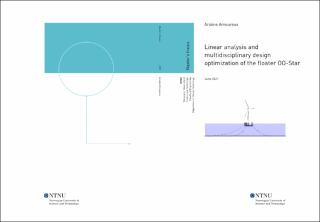| dc.description.abstract | In this report, in the continuity of B.de Renty's Master's thesis, a linear framework for the analysis and the optimization of floating wind turbines with automated diffraction/radiation computations, is proposed. A trial example is built for a simple spar floater with two design variables. Then, a linearized model of a semi-submersible floating wind turbine based on the geometry of the floater OO-Star - for which most technical documents are availabe thanks to the project LIFES 50+ - and mounted by the DTU 10 MW turbine is being studied. The implementation is made within the framework OpenMDAO. A modal approach is set up, relying on the first three non-orthogonal modes of the stucture, namely surge, pitch and the first bending mode of the tower. The agreement between the eigenfrequencies obtained from this formulation and those computed in a more classical way is good. The aerodynamics is modelled through BEM method and effective wind speeds to account for rotor frequency and blade passing effects. A first order PI controller is used for monitoring the blade pitch angle above rated wind speed. Response spectra are compared to those computed by SIMA from one-hour time domain simulations, for three different geometries of the floater and three environmental conditions. Good trends are observed but the lack of aerodynamic damping due to the simple controller, the overestimation of the 3P excitation associated with effective wind speed formulation and the too simple mooring model lead to overestimations in surge, pitch and tower bending stress. Two design variables are selected and are used to perform an exploration of the design space, where good trends are captured with the same overestimations as for the response spectra. Some elements to improve the model are proposed in the end. In the future, such a tool could help in the first design phase of any new floater. | |
